The
Sectarians in America: The Jumpers
Leben: a journal of
Reformation Life, Volume 5, Issue 4, Oct-Dec 2009
Review by Andrei Conovaloff, February
11, 2010. Updated
April 27, 2015. All updates in red font.
On 15 May 2014, this erroneous
article was shortened and posted on the commercial
WND (WorldNetDaily) website with one photo, under
a misleading title and author:
Cloud
of Witnesses: Did Russians In L.A. 'Found'
Pentecostalism? The editors of Leben discover
history of the Molokan immigrants. By Lillian
Soklokoff, A.B.
Answer: No! Molokane have no
connection with Pentecostalism. This article is
an edited excerpt from a 1918 report by a U.S.C.
sociology graduate student.
Warning to writers,
editors, journalists, scholars: Always Invite study
subjects to proofread your text.
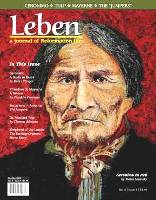 In
September 2009, the religious history journal Leben In
September 2009, the religious history journal Leben (Fresno,
California) asked (e-mail below) for
images for an upcoming article about Spiritual
Christian Molokans
in Los Angeles. I replied (below) noting that
all "Spiritual Christian Molokan"
congregations in Los Angles are of the Dukh-i-zhiznik Jumper
religion, provided many references about Spiritual
Christians Molokans,
and asked to "proofread BEFORE
you publish, to reduce errors", which did not
happen. By not collaborating, a
sloppy article was published. Pay attention writers,
journalists, scholars, editors.
By November 1, 2009, the Leben.us website showed
the cover of the October-December issue, listing
the article with "Jumprs" misspelled, which was
corrected after I sent a complaint. The link was
posted on Molokane.org and I subscribed online
to read the magazine as advertised, but could
not. Then I complained twice (by e-mail and
phone message) with no response. In January I
received the next issue by mail and complained
again (4th complaint), and finally got the issue
I wanted, right. Customer service was poor.
Beginning in 1928,
Spiritual Christian Prygun (Jumper)
sect in America was being converted to
various Dukh-i-zhiznik
cults; and was completely extinguished
by
1950.
Besides obvious errors, in my opinion the
article lacked focus. Below is the article as
published in black font with errors corrected
and comments in red. With so
many blunders in this one article, Leben readers
should check source material before relying on
other articles.
"Leben" is German for
"Life." The magazine was founded by Pacific
University in Fresno, California, and has
since moved to Sacramento. The full name is Leben:
A Journal of Reformation Life Magazine.
"Reformation Life" refers to the history of
Protestantism. Leben has covered Russia many
times. In it's first year, the third issue of
Leben featured "consequences of the
religious wars that devastated Europe, and how
God used those horrific events to send streams
of Protestant immigrants into Russia .
..."The
Great Russian Trek", "Princess
Palatine Elizabeth", "Harvest of Sorrow",
and in a later issue: "The
Odessa Church Today", and Kurt
Snow wrote a brief article about the
songbook used by Germans in Russia: "Wolga
Gesangbuch - The Volga Hymnal", Leben, 2005 Jul-Sep (v.1,
i.3). This hymnal should be compared with Spiritual Christian Molokan
and Jumper hymns to find any
borrowed songs.
Leben has a small staff
and budget. Sometime after 2010, back issues
were posted on their website. See the original
Oct-Dec 2009 PDF issue with errors
corrected below.
From:
"Kurt Snow" <production@leben.us>
Date: Mon, September 14, 2009 4:17
pm
To: administrator@molokane.org
Subject: Use of images for a
magazine article
We publish a small, non-profit magazine (1,700
subscribers) about church history called "Leben:
A journal of Reformation Life". Our next issue
will include an article about the Spiritual
Christians Molokans
in Los Angeles during the early 1900s. We are
searching for photos, paintings and other images
to help illustrate our article. Would you have
any photos that we might be able to use in our
magazine? If so, do you have the image in a
high-resolution format (300 dpi)? We would, of
course, credit you in the article. Thank you for
your reply. You may review our magazine at
www.leben.us.
From:
administrator @ molokane.org
Sent: Wednesday, September 16, 2009 11:48 PM
To: "Kurt Snow"
<production@leben.us>
Subject: Re: Use of images for a magazine
article -- Spiritual Christian Molokans
Kurt:
1. Please let us proofread BEFORE you publish,
to reduce errors.
2. Please, do not confuse Spiritual
Christian Molokans
with Dukh-i-zhizniki Jumpers.
This is the most common mistake of journalists.
All congregations in Los Angele now are Dukh-i-zhizniki
Jumper-S&L-user,
not Molokan, though they mis-label themselves
Molokan,
sometimes as "Holy
Jumper."
3. All Molokan
congregations in the US are near you, in
SF and Sheridan
4. I'd be glad to help if I knew what topics,
themes, focus, story lines you are considering.
5. Most published literature in the US is about
LA Dukh-i-zhizniki Jumpers.
Did you study?
6. I have no excellent early photos of LA
Pryguny
Jumpers. But, I do have
many color photos of current buildings, the UMCA
Heritage Room museum-bookstore, the UMCA
picnic, ... which have not been posted.
7. I looked at your web site and find you
wrote about the Germans from Russia Volga
Hymnal. Dukh-i-zhizniki
We also have songbooks with
many borrowed songs (no notes) and would like a
music expert to compare melodies and verses.
See. MHC
Volume IV The Origins of Spiritual
Christian Molokan
Singing, By Dr. Linda O'Brien-Rothe. 60
page book and 45 minute tape. Taped and
musically notated examples show how Spiritual
Christian Dukh-i-zhiznik Molokans
[Jumpers] borrowed melodies from old
Russian village folk songs. Proofread by over 70
Dukh-i-zhizniki Jumpers.
http://www.molokane.org/HRSSRS/index.htm#MHC
8. This should be enough to keep you busy.
Andrei
Phone
|
The
Sectarians
in America: The Jumpers
Click on images to
read scanned pages 9, 10, 18, and 19, from Leben, Vol. 5.4,
Oct-Dec 2009.
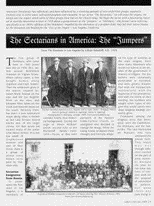
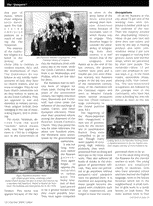

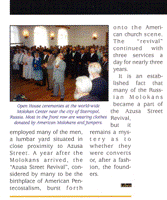
[This erroneous article
is not about "Jumpers." It appears to have been
quickly written by one person and edited by another,
with neither doing much fact checking. Some topics are over
reported, like the neighborhood location which could be
better explained with a map. Other parts are scant, like
the description of the prayer service; or omitted, like
diet and pacifism. An obvious blunder is showing
www.molokanS.org
3 times on photo credits, instead of www.molokanE.org. References for 3 editorial comments are
lacking. Whether
Doukhobors are actually in "Grand Junction" without
showing the state (Colorado?), was not checked. It
should be "Grand Forks, B.C." Since this series is about
"Sectarians in America", the Russian sectarian Molokane, Pryguny, Doukhobors
(Dukhoborsty) and Sabbatarians (Subbotniki)
would be much better covered in separate articles, or in
one article about Russian "Spiritual Christians" in
America or North America, and each covered in a section.
The distinction between Dukh-i-zhiznik, Prygun Jumper
and Molokan sects
is not clear and the terms erroneously used as synonyms.
The history of Pryguny Jumpers is scant. More source
material and notes should have been cited, as in Scott's: "The
Pilgrims of Russian-town Seventy Years Later." More comments
follow in the article below and at the end.]
American Christianity has influenced, and been influenced
by, a stunning panoply of non-conformist groups,
separatist enclaves and, in some cases, self-styled
prophets and messiahs. In our series "The Sectarians," we
will trace the origins, the beliefs and the impact which
some of these groups have had on the Church today. We
begin the series with a fascinating report we've recently
discovered written in 1918 about a group known as the Spiritual Christian Pryguny or "Jumpers," or "Molokans,"
(the former name referring specifically
to an 1830's sect of formed in New
Russia, now Zaparozhie oblast, Ukraine, by zealous people from many different
faiths who were attracted by prophesies of an apocalypse
during a famine and adapted
charismatic spiritualism from neighboring Jumpers (Hupfers) from
Germany offshoot of the Molokans).
See Zhuk, Serguei. (2004) Russia’s
Lost Reformation: Peasants, Millennialism and Radical
Sects in Southern Russia and Ukraine, 1830-1917.
After one-third (7,411) of all Doukhobors fled from the
Caucasus in 1899, various non-Doukhobor Spiritual
Christians, mostly Pryguny, moved to California
mostly for economic reasons and resettlement guidance
offered by Captain P.A. Demens, a Russian-born business
man promoting immigration to booming Southern
California. A minor number were motivated Impelled
by the utterances of a grown prophet-child,
E.G. Klubnikin they
left their native Russia by the thousands and headed for
the "City of the Angels" — Los Angeles, California.
See Dukh-i-zhizniki
in America, Why did they wait so long in Russia? Why
did 99% stay in Russia?
Adapted from
The
Russians in Los Angeles by Lillian Sokoloff, A.B.,
1918, graduate student, Department
of Sociology, University of Southern California, Los
Angeles.
[The reader should study Sokoloff's
18-page paper documenting that 94% of the
sectarians from Russia in Los Angeles were Pryguny. The Leben editors
omitted this fact which will mislead readers. Though
Sokoloff notes these early immigrants from Russia were a
mixture of historically related Spiritual Christians,
she missed the Armenian Pryguny, and clustered all
non-Orthodox immigrants from Russian together.]
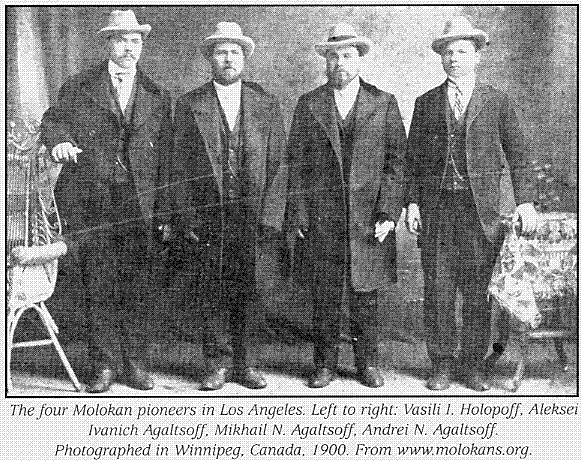 The first group
of Spiritual
Christians Molokans, who came here in 1905 [some date
this as 1904, Ed.], settled
around Bethlehem
Institute on Vignes Street. When others came, a few
bought homes along Clarence and Utah Streets. Then the
settlement grew in the district situated between Boyle
Avenue on the east and the Los Angeles River on the west,
and between Aliso Street on the north and Seventh Street
on the south. Recently there has been a new settlement
made along what is known as Salt Lake Terrace several
blocks east of the larger colony. On that street are
located many of the somewhat better homes. In a hollow
south of Stephenson Avenue [renamed Whittier Boulevard in 1922] and
east of Mott Street, there is a group of about sixty
houses occupied by Russians only [called Karakala by locals]. The first group
of Spiritual
Christians Molokans, who came here in 1905 [some date
this as 1904, Ed.], settled
around Bethlehem
Institute on Vignes Street. When others came, a few
bought homes along Clarence and Utah Streets. Then the
settlement grew in the district situated between Boyle
Avenue on the east and the Los Angeles River on the west,
and between Aliso Street on the north and Seventh Street
on the south. Recently there has been a new settlement
made along what is known as Salt Lake Terrace several
blocks east of the larger colony. On that street are
located many of the somewhat better homes. In a hollow
south of Stephenson Avenue [renamed Whittier Boulevard in 1922] and
east of Mott Street, there is a group of about sixty
houses occupied by Russians only [called Karakala by locals].
[In the photo right
showing relatives who scouted North America about 1900
for immigration sites. Vasili
(William)
Halopoff
was
the first and only Molokan known to have enlisted in
the Canadian Expeditionary Forces (army) in World War
One. He wrote his religion as "Brotherhood" with
no space to add "of Spiritual Christians." He was
reported missing
in
action
December 10, 1917. Though claiming to be
pacifists, more Spiritual Christians enlisted in WWII
than registered as Conscientious Objectors (but about
half served as non-combatants); and Dukh-i-zhizniki who
avoided the military during WWII by performing Alternate
Service in CO camps, failed pay nearly half (46%) of
their camp fees, defaulting
on $17,000 in debt in 1944. They made no effort to
reimburse the Society of Friends (Quakers) and Mennonites who operated the camps
though one, Alex Shubin, often asked members to
collectively pay the shameful bill.]
Sectarian Emigration from
Russia.
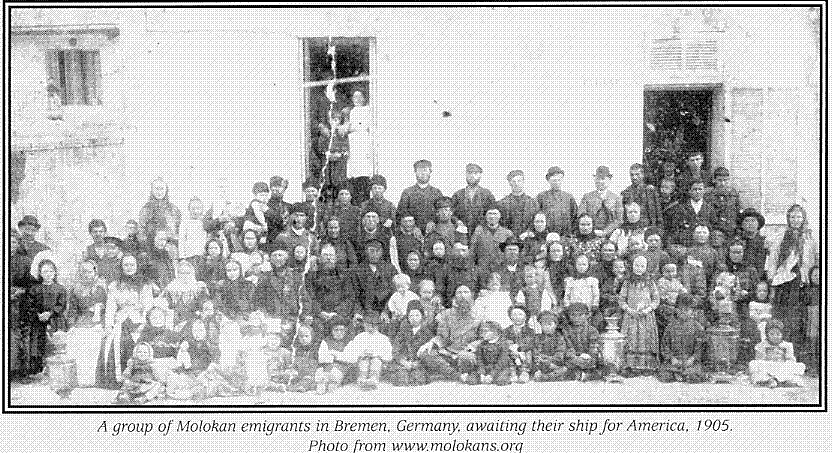 To understand these immigrants from Russia To understand these immigrants from Russia Russians
in Los Angeles, it is necessary to consider briefly their
historical backgrounds. During the reign of Alexis
Michaelovitch, second ruler of the Romanoff family —
1645-1676 — Nicon [Nikon], at that time
patriarch of the Russian Greek-Catholic Church,
investigated and decided to change the liturgy. While the
ruling house accepted these changes and formally adopted
this type of worship as the stat religion, there were many
dissenters who would not submit to the dictates of the
government in matters of religion. The dissenters were
continually persecuted or banished, and were greatly
dissatisfied with the bureaucratic institutions, with the
hypocrisy of the priesthood, and with the forms of their
worship, the numbers who sought other types of religion
that would satisfy their deep religious feelings
constantly grew.
Prominent among the religious sects that developed, were
the Dukhobors [Doukhobors],
the Molokans, and the Subotniks [Subbotniks]. The
last-mentioned are different sects
in Russia Russians
who have variously adapted
characteristics similar to embraced
the Jewish faiths. This
result was not through influence exerted on the part of
Jews, however, because the Jews do not have any form of
mission work for the purpose of conversion to Judaism, nor
were there any Jews living in that part of Russia where
these religious sects developed. The Subbotniks embraced
Judaism as a result of reading the Old Testament. [See a 2014 book review about the origin
of Subbotniki: Origin
of Sects in Old Russia Explained : Credit or blame
Peter the Great.]
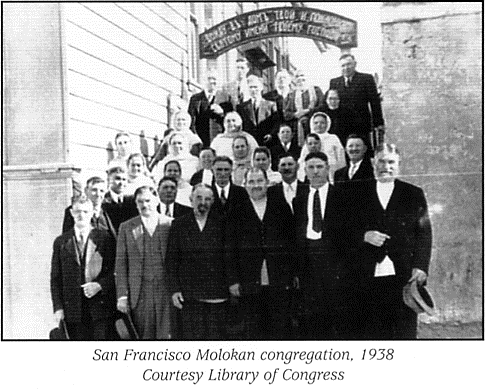 The essence of the
Doukhobor religion is a belief in the divinity of Christ
[this is contrary to modern sources, Ed.], and the
brotherhood of man. The Dukhobors [Canadian
spelling: Doukhobors] do not believe in any
earthly representative of God; they have no church
leaders, and no icons or images. They do not have church
ceremonies nor do they believe in saints as do the Greek
Catholics. They are opposed to war and therefore to
military service. Their religion forbids their indulging
in the use of intoxicating liquors, and in smoking. The essence of the
Doukhobor religion is a belief in the divinity of Christ
[this is contrary to modern sources, Ed.], and the
brotherhood of man. The Dukhobors [Canadian
spelling: Doukhobors] do not believe in any
earthly representative of God; they have no church
leaders, and no icons or images. They do not have church
ceremonies nor do they believe in saints as do the Greek
Catholics. They are opposed to war and therefore to
military service. Their religion forbids their indulging
in the use of intoxicating liquors, and in smoking.
[This photo of Molokane in San
Francisco and following partial history of the Molokan
faith is confusing in an article about Pryguny and Dukh-i-zhizniki in
Los Angeles. These are different faiths 400 miles apart
in America.]
The name "Molokan, derived from the word "moloko" which
means milk, was first applied to them in 1765 by a
religious sect in the Government of Tambov. This name was
applied because of the fact that the Molokans drink milk
every day in the week, while the Greek Catholics abstain
from it on Wednesdays and Fridays, which are fast days for
them.
The Molokans had no definite form of religion for many
years. During the last years of the seventeenth century,
two highly educated men, Skovoroda and Tveritinoff, had
come under the influence of the teachings of Luther,
Calvin, and other European reformers. These men then
preached reform among the dissenters of the Russian
Greek-Catholic Church. They thus paved the way for other
reformers. For about one hundred years, the Molokans were
unmolested by the governmental authorities.
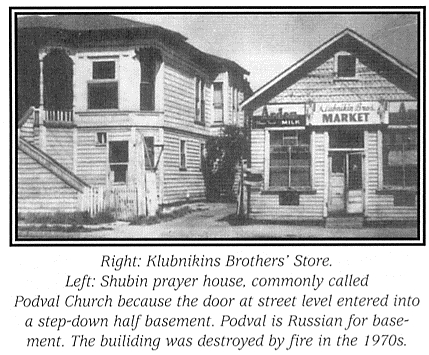 It was not long, however,
before the Russian government again began to oppress the
sectarians in various ways. The heavy taxation of their
land proved to be a greater burden than they could
possibly bear. They were again compelled to serve in the
army. Some of the more educated among them foresaw
disastrous times because of inevitable wars in which
Russia was to engage. They therefore began to consider the
advisability of emigration from their country. It is well
known that of the emigrants from Russia up to the end of
the last century, the greatest number were Jews and a
smaller per cent were Poles, but scarcely any Russians
proper. In the last two years of the nineteenth century,
many of the Spiritual
Christian Dukhobors left the Caucasus region and
went to Western Canada where several thousands now live.
[There remains a large community in the Grand Junction [Grand
Forks, British Columbia] area, Ed.] It was not long, however,
before the Russian government again began to oppress the
sectarians in various ways. The heavy taxation of their
land proved to be a greater burden than they could
possibly bear. They were again compelled to serve in the
army. Some of the more educated among them foresaw
disastrous times because of inevitable wars in which
Russia was to engage. They therefore began to consider the
advisability of emigration from their country. It is well
known that of the emigrants from Russia up to the end of
the last century, the greatest number were Jews and a
smaller per cent were Poles, but scarcely any Russians
proper. In the last two years of the nineteenth century,
many of the Spiritual
Christian Dukhobors left the Caucasus region and
went to Western Canada where several thousands now live.
[There remains a large community in the Grand Junction [Grand
Forks, British Columbia] area, Ed.]
[The prayer house
(photo right) was occupied by a congregation founded by
prophet E.G. Klubnikin, was the most zealous of the Dukh-i-zhiznik congregations, and today
is divided
into 5-7 branches. The photo was taken in the "Flat(s)", on
Clarence Street, south of First Street.]
The beginning of the Russo-Japanese
War [1904-1905]
inaugurated a new era of persecutions for the sectarians
in southeastern Russia. They were compelled to go to war and pay war tax. Though many were
capable of occupying high military positions, they were
prevented from so doing and were put to the most menial
work. They also suffered all kinds of insults at the
instigation of government officials. They were not
permitted to go anywhere without passports — and passports
were not granted them. It is therefore not surprising that
these people became disgusted with conditions such as they
experienced, and longed to leave the country.
Occupations
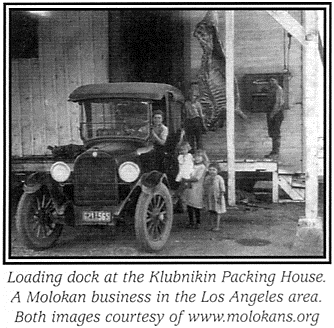 Of all
the immigrants from Russia Of all
the immigrants from Russia Russians
in this city, about 75 per cent of the working men were
employed in lumber yards up to the outbreak of the war. [Russian-born P.A. Demens owned one of
the larges lumber yards, and invited his country men to
Los Angeles.] Then the majority entered the
ship-building industry. About 10 per cent own and drive
their own teams, and work by the day in hauling produce
and other commodities. About 2 per cent are engaged in
running little grocery stores and butcher shops, which are
patronized by their own people. The remainder — about 13
per cent — are employed in various ways, e. g., in the
metal trades, automobile shops, planing mills, fruit
canneries. The last-mentioned occupations are followed by
the younger men of the community, who have had some
schooling but who left school as soon as the law permitted
them to do so.
It is the usual thing among the Russians for the married
women to work. The young women are employed chiefly in
laundries. Girls who have attended school and have learned
the English language, work in the biscuit factories which
are in the neighborhood. A small number of girls work in a
candy factory on Utah Street. The older women work in
fruit canneries or do housework by the day. Though many of
the girls who have been to school for several years, could
do other work and perhaps earn more money, the parents are
anxious to have them work near home and among their own
people. Clerking or office work might cause the girls to
become "Americanized" quickly and to this the older people
object.
The religion of the Molokans (1765) sprang from the same origin as that of
the Dukhobors (1785) —
from ikonobory, khristovoverei and their
precursors. Both these sects are opposed to war.
They believe in no earthly representatives of God. The
Molokans have no ministers or church dignitaries of any
kind. They have no rules or traditions as to who shall be
their religious advisers. Their pastors are not ordained,
do not receive compensation, and are not dependent upon
the approval of the community. Their authority prevails
only at prayer meetings, marriage ceremonies, and funeral
services. It may be said that the Molokan religion has
little definite form. It is systemless. Many of its phases
are exceedingly crude. It is incoherent and inconsistent.
Like the orthodox Jews, the Molokans abstain from eating
pork and are supposed to slaughter their beef in a certain
manner.
There are at present seven diaspora
Dukh-i-zhiznik meeting halls churches
in east Los angles County the
Russian settlement , and
more are dispersed in the Central Valley, central
Oregon, and Australia. [See map.]
These are simply very large rooms in which church
services are conducted. All have
kitchens for meal preparation. During
holidays, some Small
congregations use private homes for meetings are
also used for religious services. The Dukh-i-zhizniki
Priguni
conduct their prayers in a unique manner only in the Russian language. Typically, after formal prayer rituals,
many sing All pray aloud for
some time, until one feels that the "spirit" has entered
into him, when in a trance-like manner he comes to the
center of the place of worship. The praying goes on in a
sing-song loud tone of voice until one by one, every
person feels the "spirit" within him by raising both hands and/or jumping ....
[This is a simplified description of
a complex ritual which varies depending on the people
involved, their fluency in the Russian language, past
relations to each other, location, purpose for meeting,
interaction, whether a prophesy was delivered, the song
being sung, timing, and other factors. Sometimes no one
raises hands or jumps, sometimes one person, other times
many. Sometimes the prophesy is ignored, sometimes it is
relayed to other select congregations. A few
congregations require charismatic raising of hands,
jumping and singing by all members or specific members.]
[Southern California
Pryguny transformed
to Dukh-i-zhizniki after 1928. In America, 4
Prygun congregations
persisted up to 1950 in Arizona, Mexico, San Francisco,
and shortly in Los Angeles among new immigrants from
Iran.]
Abridged from: Studies in Sociology, SOCIOLOGICAL
MONOGRAPH NO. 11. Vol. III MARCH 1918 No. 3. EDITED BY
EMORY S. BOGARDUS, Department of Sociology. University of
Southern California, Originally published by the
University of Southern California Press. Los Angeles,
California. For the complete text, please visit:
http://www.archive.org/stream/russiansinlosang0lso
ko/russiansinlosang01soko_dj vu.txt [The complete original 1918 document
is
online
in 6 formats on the Text Archive, and on Google
Books in Sociology and social research, Volumes
1-5. See the report updated and corrected: The
Russians in Los Angeles by Lillian Sokoloff,
1918.]
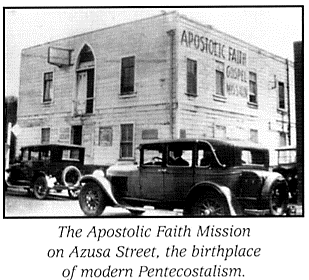 While
there are still numerous groups in the U.S. and in Canada
that are direct descendants of the Molokan and Doukhabor [Doukhobor] sects,
their influence may have had a
minor impact While
there are still numerous groups in the U.S. and in Canada
that are direct descendants of the Molokan and Doukhabor [Doukhobor] sects,
their influence may have had a
minor impact well have been enormous
on what is today generally referred to as Pentecostalism.
[Only the Pryguny
in Los Angeles
interacted with charismatic Pentecostals before 1928 at the Apostolic Faith
Mission (Azusa Street Revival). After 1928 a few choirs
organized by Dukh-i-zhiznik singer John Slevcove
sang on Aimee
McPherson's radio program at Angeles Temple; and,
she visited the Armenian Apostolic Church (Pentecostal, Breed St.
at 6th St.), which separated from the Armenian Prygun
faith.]
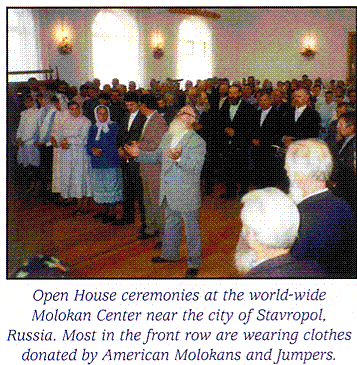 The Spiritual Christians Molokans,
especially of the "Prygun Jumper"
variety, had a long history of laying claim to modern-day
manifestations of the apostolic gifts, including healings,
tongues, etc. When they moved to Los Angeles, California,
most settled near the lumber yard that employed many of
the men, a lumber yard situated in close proximity to
Azusa Street. A year after the Spiritual Christians Molokans
arrived, the "Azusa Street Revival", considered by many to
be the birthplace of American Pentecostalism, burst forth
into the American church scene. The "revival" continued
with three services a day for nearly three years. The Spiritual Christians Molokans,
especially of the "Prygun Jumper"
variety, had a long history of laying claim to modern-day
manifestations of the apostolic gifts, including healings,
tongues, etc. When they moved to Los Angeles, California,
most settled near the lumber yard that employed many of
the men, a lumber yard situated in close proximity to
Azusa Street. A year after the Spiritual Christians Molokans
arrived, the "Azusa Street Revival", considered by many to
be the birthplace of American Pentecostalism, burst forth
into the American church scene. The "revival" continued
with three services a day for nearly three years.
[This photo (right) is not about Pryguny
and was taken in Russia. The caption should say:
"...clothes donated by American Molokans and Dukh-i-zhizniki
Jumpers.]
It is an established fact that some
many of the Pryguny from Russia Russian
Molokans became a part of the Azusa
Street Revival, but it remains a mystery as to
whether they were converts or, after it began a fashion, the
founders.
In addition to the above text in red
font:
- How the Pentecostal movement in
America was founded in Europe, and maybe Africa, and
transported to America before 1900 is not mentioned.
- The proper historical
label of Dukhovnye khristiane
pryguny (Spiritual
Christian Jumpers) was never used in this
article.
- The photo (above) of
the "world-wide Molokan Center" is outside the theme,
mislabeled, and misleading. This Russian Molokan organization
is called Союз духовных христиан—молокан (СДКМ,
website: SDKM.ru), Souiz dukhovnykh
khristian—molokan, Union
of
Spiritual
Christian Molokans (USCM) — "Molokan Center"
in short.
- Dukh-i-zhizniki,
the subject of this article, do not support or
recognize Molokane,
and generally consider themselves spiritually superior
to all other faiths (whom zealots label with the mark
of the beast, 666).
- The reader would
probably want to know more about the "apostolic gifts"
which are merely mentioned in this summary, yet this
is outside of Sokoloff's 1918 paper and appears at the
end, like a teaser.
- Historic
documentation of Pryguny
attending the Azusa
Street
Revival is scant (4 count), and should be
another article. There is very little documentation
about the interaction because zealots attacked
inter-denominational fellowship as heresy and anyone
who tried to document it.
- The conclusion that
American Pryguny were
"converts" to the Azusa
Street
Revival may
apply only to a few Armenian-Jumpers,
because they later adapted the label Pentecosts; and
indirectly to individual Pryguny who abandoned their
Russian heritage faiths and labels, and avoided the zealous and
uneducated to intermarry and/or melt into America
and English-speaking churches. Some changed their
Russian last name. Many chose American churches with
a similar Protestant theology, like Vineyard, E.V.
Free, .... More than half (estimates up to
90%) of the descendants of Spiritual Christian in
America have joined or primarily attend other faith
churches. Some are duo-faith — paying dues in a Dukh-i-zhiznik congregation and/or
cemetery, while attending (even baptized in) an
"American" faith. Faking alliance with the Dukh-i-zhizniki
allows one to avoid discrimination by the most
zealous while participating in family funerals,
weddings, and holidays. One Vineyard church
in Whittier, California, reportedly had as many as 40%
of its attendance from descendants of Dukh-i-zhizniki.
Conversion of sectarian descendants should be another
article, about which there is very little
documentation.
- There has never been
any previous suggestion or documentation that Pryguny were the
"founders" of American Pentecostalism or that their
"influence ... [was] enormous ... [on] ...
Pentecostalism" as stated in the article, though many
joined and contributed. The best example is Demos
Shakarian, who descended from Armenian-Pryguny, founded
the Full
Gospel Business Men's Fellowship International
(FGBMFI), and published: The Happiest People on Earth.
Shakarian first hosted Oral Roberts Ministries in the
Los Angeles area in the 1950s. Several lesser renown Prygun descendants
have become ministers or missionaries in their
new-world non-pentecostal congregations (John Michael
Novikoff, Dr. William John Samarin (Grace Brethren),
David Joseph Shinen, Jim Klubnik, Steve Bogdanov (The Temple),
etc), and some probably have taken leadership
positions (deacons, board members, teachers,
newsletter editors, financial supporters, and
missionaries), but there is no documentation about
this history, and their impact on Pentecostalism is
very minor, compared to Shakarian's.
- Any participation
with or attention to "other" faiths by descendants of
diaspora Pryguny or Dukh-i-zhizniki
has been attacked as heresy by the most zealous Dukh-i-zhizniki
for most of the past century. Listening to a
Christian radio broadcast can result in reprimand, if
found out by a zealot.
- After 1992, the
revitalization and registration of the Spiritual
Christian Molokan faith in the Former Soviet
Union caused the diaspora Dukh-i-zhiznik
cults, who falsely claim to be true "Molokans," to
further hide, while they funded several refugee
congregations of Dukhizhizniki now in the
South Russia provinces of Stavropol' (from Kars
(Qars), Turkey, since 1962) and Krasnodar (from
Armenia since 1992).
|
